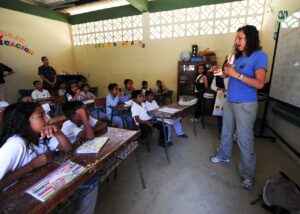Bridging Gaps and Overcoming Challenges: The State of Education in the Philippines
The government has made significant investments in education to increase enrollment rates and improve access to education, especially in remote areas.

Pixabay
The education system in the Philippines has seen significant progress over the years, but it continues to face numerous challenges that hinder its ability to deliver quality education to all Filipinos.
Despite government efforts to improve the sector through reforms such as the K-12 program, issues such as inadequate infrastructure, lack of teacher training, high dropout rates, and educational inequality persist.
This essay will examine the current state of education in the Philippines, exploring its achievements and ongoing challenges, while proposing ways to address these concerns.
Achievements and Reforms
One of the major reforms in recent years was the implementation of the K-12 program, which extended the country’s basic education cycle from 10 to 12 years. The reform aligned the Philippine education system with international standards, ensuring that Filipino students are more competitive globally.
According to the Department of Education (DepEd), the K-12 curriculum was designed to “provide sufficient time for mastery of concepts and skills, develop lifelong learners, and prepare graduates for tertiary education, middle-level skills development, employment, and entrepreneurship” (Department of Education).
Additionally, the government has made significant investments in education to increase enrollment rates and improve access to education, especially in remote areas.
A 2020 World Bank report said, public spending on education increased steadily over the past decade, and literacy rates improved to over 98% for younger generations (World Bank). These efforts demonstrate the government’s commitment to improving the sector, but several systemic issues remain.
Infrastructure and Resource Challenges
A major issue plaguing the Philippine education system is inadequate infrastructure.
Many schools, especially in rural and underserved areas, suffer from overcrowded classrooms, poor facilities, and a lack of teaching materials.
A 2019 study by the Philippine Institute for Development Studies (PIDS) highlighted that in some provinces, students still share textbooks and often attend classes in makeshift classrooms due to a shortage of proper school buildings (Orbeta et al. 3).
The lack of sufficient resources creates an environment where effective learning is difficult, particularly for students in public schools.
Teacher shortages and the need for improved teacher training also affect the quality of education. While the student population continues to grow, the number of qualified teachers has not kept pace.
Many teachers, especially in public schools, are overworked, and opportunities for professional development are limited. It affects not only their morale but also the learning outcomes of their students.
A report from UNESCO found that the Philippines has a student-to-teacher ratio of 30:1, far above the ideal ratio of 20:1, and many teachers are assigned to teach subjects outside their field of expertise (UNESCO 17).
High Dropout Rates and Educational Inequality
One of the most pressing issues in the Philippine education system is the high dropout rate, particularly at the secondary level.
Poverty remains a key factor. Many students leaving school to support their families financially.
According to the 2020 Annual Poverty Indicators Survey, approximately 21.4% of Filipino children aged 6-24 are out of school, with economic hardship cited as the primary reason (Philippine Statistics Authority).
The survey results reflect the deep-rooted inequalities in the country’s education system, where students from lower-income families face greater barriers to completing their education.
Educational inequality is further exacerbated by the digital divide, which has become more pronounced during the COVID-19 pandemic.
The shift to online learning have been disproportionately affects students from impoverished families who lack access to computers, stable internet connections, or even electricity.
UNICEF, in a study, reported that in 2021, over 2.7 million Filipino students lacked access to the necessary technology for distance learning (UNICEF Philippines). The digital divide underscores the urgent need for reforms that address inequality in access to education and resources.
Ways Forward
To address the challenges in the Philippine education system requires a multifaceted approach.
First, increased investment in infrastructure is crucial.
The government must prioritize the construction of more classrooms, the provision of modern learning materials, and the improvement of school facilities, especially in rural and underserved areas. The DepEd should also work to reduce the student-to-teacher ratio by hiring more qualified teachers and providing ongoing training to ensure they can effectively deliver the curriculum.
Second, to tackle the issue of dropout rates, the government should strengthen social safety net programs that provide financial assistance to students from low-income families.
Programs like the Pantawid Pamilyang Pilipino Program (4Ps), which offers cash transfers to families who meet certain health and education conditions, have shown promise but require expansion to reach more vulnerable students.
Additionally, closing the digital divide is essential for ensuring that all students have access to education in the modern era. It involves improving access to technology and internet services, particularly in rural areas.
The government should collaborate with private sector partners to provide affordable internet services and devices to students and educators.
Finally, greater emphasis should be placed on promoting equity in the education system. This includes creating policies that ensure marginalized groups, such as Indigenous peoples and students with disabilities, have equal opportunities for learning.
Providing culturally sensitive education and inclusive teaching practices can help reduce disparities.
Conclusion
The Philippines has made important strides in reforming its education system through initiatives like the K-12 program. But it continues to grapple with challenges related to infrastructure, teacher quality, dropout rates, and educational inequality.
To improve the state of education, the government must increase investment in school infrastructure, address teacher shortages, and implement programs that target students from marginalized communities.
The Philippines can create an education system that fosters inclusivity and prepares its students to succeed in a rapidly changing global landscape by focusing on equity and access.
Works Cited
Department of Education. “K to 12 General Information.” Department of Education, https://www.deped.gov.ph/k-to-12/. Accessed 01 Oct. 2024.
Orbeta, Aniceto C., et al. “On the Costs of the K-12 Program.” Philippine Institute for Development Studies, 2019, https://pidswebs.pids.gov.ph/CDN/PUBLICATIONS/pidsdps1812.pdf.
Philippine Statistics Authority. “Annual Poverty Indicators Survey 2020.” Philippine Statistics Authority, https://psa.gov.ph/content/annual-poverty-indicators-survey-apis. Accessed 01 Oct. 2024.
UNESCO. Education for All 2021 Global Monitoring Report. UNESCO, 2021, https://unesdoc.unesco.org/ark:/48223/pf0000377486.
UNICEF Philippines. “UNICEF Calls for Urgent Action to Address Learning Gaps Exacerbated by COVID-19.” UNICEF, 2021, https://www.unicef.org/philippines/stories/unicef-calls-urgent-action-address-learning-gaps-exacerbated-covid-19.
World Bank. “Philippines – Education Sector Overview 2020.” World Bank, 2020, https://data.worldbank.org/country/philippines.








